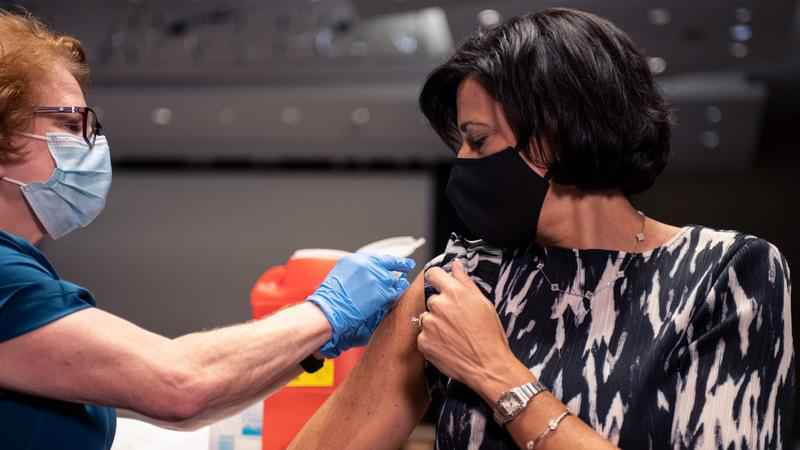US health experts urge flu shots to avoid ‘twindemic’

In this photo provided by the National Foundation for Infectious Diseases, CDC Director Rochelle Walensky receives her flu shot on Tuesday, Oct. 5, 2021 in Atlanta. The U.S. is gearing up in case of a bad flu season on top of the continuing COVID-19 crisis, with a plea Thursday for Americans to get vaccinated against both.[National Foundation for Infectious Diseases via AP]
The U.S. is gearing up in case of a bad flu season on top of the continuing COVID-19 crisis, with a plea Thursday for Americans to get vaccinated against both.
“I get it: We are all tired of talking about vaccines,” said Dr. Rochelle Walensky, director of the Centers for Disease Control and Prevention.
But “it is doubly important this year” to get your flu shot, added Walensky, who got her own vaccination earlier this week just as she has every year since she was a medical student in 1995. “We are preparing for the return of the flu.”
Flu cases dropped to historically low levels globally over the pandemic, as restrictions designed to slow the spread of the coronavirus helped block other respiratory viruses. But with schools and businesses reopened, international travel resuming and far less masking, there’s no way to predict how bad a flu season the U.S. might expect this winter.
But officials are worried because a different respiratory virus, named RSV, that usually attacks young children in the winter instead roared back last summer as soon as people started dropping their masks.
“Is that a harbinger of a worse influenza season? We don’t know, but we certainly don’t want a ‘twindemic,’ both COVID and influenza,” said Dr. William Schaffner of the National Foundation for Infectious Diseases.
And if you still need a COVID-19 vaccination — either first shots or a booster dose — you can get it at the same visit as a flu shot.
The CDC recommends a yearly flu vaccination for just about everyone starting with 6-month-old babies. Influenza is especially dangerous for older adults, children under age 5, people with chronic health problems such as diabetes, asthma or heart disease, and during pregnancy.
Last fall, about as many Americans overall got their flu vaccination as they did before the pandemic — about half of the eligible population, according to CDC data released Thursday. But Walensky was dismayed by a slight drop in child flu vaccinations last year — and at widening racial and ethnic disparities. Last year, 43% of Black Americans and 45% of Hispanics got a flu vaccination compared to 56% of whites.
The CDC expects vaccine makers to deliver 188 million to 200 million doses of flu vaccine. Most Americans with insurance can get one without a co-pay. Options include regular shots, shots that aim to give older adults a little extra protection, and a nasal spray. All offer protection against four different flu strains that global experts predict are the kinds most likely to spread this year.
At the same time they get vaccinated against flu, officials also urged older adults and people with chronic illnesses to ask about getting a vaccine against a type of pneumonia that is a frequent complication.